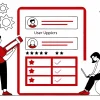
Third-Party Feedback Solutions vs In-House Feedback Systems
In today’s competitive business landscape, gathering customer feedback is more crucial than ever. Companies often grapple with the decision of implementing Third-Party Feedback Solutions vs In-House Feedback Systems.
Each approach has unique advantages and drawbacks, and the choice between them can significantly impact your company’s ability to gather, analyze, and act on feedback effectively.
What Are Third-Party Feedback Solutions?
Third-party feedback Solutions involve outsourcing the process of collecting and analyzing customer feedback to specialized companies or software providers. These solutions often come with pre-built tools, platforms, and expertise that allow businesses to efficiently gather feedback across various channels.
Key Features of Third-Party Feedback Solutions
- Comprehensive Tools: Third-party solutions typically offer a wide range of tools for surveys, polls, and feedback forms that can be customized to meet specific needs.
- Advanced Analytics: Many third-party platforms provide robust analytics features, enabling businesses to dive deep into data to identify trends and insights.
- Multi-Channel Integration: These solutions often support feedback collection across multiple channels, such as websites, mobile apps, social media, and email.
What Are In-House Feedback Systems?
In-House Feedback Systems are feedback collection and analysis mechanisms developed and managed within an organization. These systems are tailored to meet the specific needs and preferences of the company.
Key Features of In-House Feedback Systems
- Customization: In-house systems can be tailored to precisely fit the organization’s feedback needs, ensuring that the data collected is relevant and actionable.
- Data Control: Companies have complete control over the data, ensuring confidentiality and compliance with internal policies.
- Integration with Internal Tools: In-house systems can seamlessly integrate with existing internal tools and platforms, enhancing efficiency.
Advantages of Third-Party Feedback Solutions
Choosing Third-Party Feedback Solutions can provide businesses with several benefits, particularly in terms of efficiency and expertise.
1. Expertise and Specialization
Third-party providers are experts in feedback collection and analysis. They bring specialized knowledge, best practices, and industry-specific insights that might be beyond the reach of an in-house team. This expertise can lead to more accurate and actionable feedback.
2. Time and Resource Efficiency
Outsourcing feedback collection to a third-party provider saves time and internal resources. The company doesn’t need to invest in developing and maintaining feedback systems, allowing the team to focus on core business activities.
3. Scalability
Third-party solutions are often designed to scale with your business. Whether you’re a small startup or a large enterprise, these solutions can accommodate your growing needs without requiring significant additional investment.
Advantages of In-House Feedback Systems
Opting for In-House Feedback Systems offers distinct advantages, particularly in terms of customization and control.
1. Tailored Feedback Collection
In-house systems can be customized to align perfectly with your company’s specific feedback objectives. This ensures that the data collected is highly relevant and directly supports your business goals.
2. Data Security and Privacy
With an in-house system, your organization retains full control over all data, ensuring compliance with internal security protocols and data privacy regulations. This level of control is often a critical factor for companies in highly regulated industries.
3. Direct Integration with Business Processes
In-house systems can be directly integrated with your existing business processes, making it easier to act on feedback in real time. This integration ensures that feedback loops are shorter and more effective, leading to faster improvements in products or services.
Challenges Of Third-Party Feedback Solutions
Despite their benefits, Third-Party Feedback Solutions come with certain challenges that businesses should consider.
1. Cost Implications
Third-party solutions often come with a subscription fee or usage-based pricing. For small businesses or startups, these costs can be prohibitive, particularly if the features offered by the third-party provider exceed what the business needs.
2. Limited Customization
While third-party solutions offer various tools and features, they may lack the flexibility needed to fully customize feedback collection according to a company’s unique requirements. This can lead to collecting data that is less relevant or actionable.
3. Data Privacy Concerns
Outsourcing feedback collection involves sharing customer data with a third-party provider. Depending on the provider’s data security measures, this could pose privacy risks, especially if the feedback contains sensitive information.
Challenges of In-House Feedback Systems
Building and maintaining In-House Feedback Systems also presents its own set of challenges.
1. Resource Intensive
Developing an in-house system requires significant time, money, and expertise. Companies need to invest in software development, data management, and analytics capabilities, which can be resource-intensive, especially for smaller organizations.
2. Limited Expertise
In-house teams may lack the specialized knowledge required to design and implement an effective feedback system. This can result in a system that doesn’t capture or analyze feedback as effectively as a third-party solution would.
3. Scalability Issues
As a business grows, its feedback needs will likely expand. Scaling an in-house system to meet these evolving needs can be challenging and may require additional resources or even a complete overhaul of the existing system.
Third-Party Feedback Solutions vs In-House Feedback Systems: Comparing Features
Explore the key differences between third-party feedback solutions vs in-house feedback systems. Understand which solution offers the features that best fit your organization’s needs.
1. Cost Considerations
- In-house feedback system involve higher initial investments for development and implementation, but lower ongoing maintenance costs.
- Third-party solutions often have a subscription-based or usage-based model, leading to predictable but potentially higher cumulative costs over time.
2. Flexibility and Adaptability
- Third-party solutions allow for rapid deployment, enabling immediate feedback collection. However, customization is often limited by the provider, potentially restricting adjustments to fit evolving business needs.
- In-house systems offers tailored customization to meet specific business requirements. Implementing may be slower, with additional time needed for ongoing adjustments as business needs evolve.
3. Data Security
- Third-party solutions often include encryption and industry-standard compliance, managed by the provider. However, any data breaches or security lapses by the provider could significantly impact the organization.
- In-House system provides full control over security measures, making it ideal for sensitive or confidential data. Required significant investment in security infrastructure and expertise to maintain data protecion.
4. Scalability
- Third-party solutions can scale quickly with changing needs, as most providers offer adaptable plans for businesses of varying sizes.
- In-House system scalability is possible, though it demands strategic planning and additional investment, which may limit the speed of scaling efforts.
6. Expertise and Resources
- Third-party solutions require minima internal expertise, as the provider typically handles setup, maintenance and updates.
- In-house system demand substantial in house expertise for both initial setup and ongoing support, making it essential to have IT and development resources.
Each option has distinct advantages and potential limitations the choice depends on an organization’s specific priorities for cost, customization, security, and adaptability.
Future of Feedback Collection: Trends and Innovations
As businesses continue to evolve, so too do the methods for collecting and analyzing feedback. Whether you choose a third-party solution or an in-house system, staying abreast of industry trends can help you make the most of your feedback efforts.
1. AI and Machine Learning
Both third-party and in-house systems now leverage AI and machine learning to enhance feedback analysis, identifying hidden patterns and trends for deeper insights and more accurate predictions.
2. Omnichannel Feedback Collection
With customer interactions spanning more channels, feedback systems are evolving to capture data across all touchpoints, driving the creation of more integrated, comprehensive solutions whether third-party or in-house.
Conclusion
Choosing between Third-Party Feedback Solutions vs In-House Feedback Systems is a significant decision that can shape how your business understands and responds to customer needs.
Both options have their merits, and the best choice depends on your organization’s specific circumstances, including your budget, expertise, and long-term goals.
Whether you opt for the efficiency and expertise of a third-party solution or the customization and control of an in-house system, the ultimate goal is to create a feedback loop that drives continuous improvement and enhances customer satisfaction.
Frequently Asked Questions
Which Option Offers Better Customization For Feedback Collection?
In-house systems provide greater customization, tailored to specific business needs.
Are Third-Party Feedback Solutions Secure?
Yes, third-party providers usually follow strict security standards, though data security depends on the provider.
Which System Is Easier To Scale As The Business Grows?
Third-party solutions are generally more scalable with flexible provider plans.
How Quickly Can Each System Be Deployed?
Third-party solutions are quick to deploy, while in-house systems require longer development time.
What Are The Main Cost Differences Between Third-Party And In-House Feedback Systems?
Third-party systems have predictable subscription fees, while in-house systems have higher initial costs but lower ongoing expenses.
Enhance Patient Care and NABH Compliance with LazyMonkey
LazyMonkey is your all-in-one solution for improving patient care, retaining more patients, and meeting NABH standards. Our powerful QR-based feedback tool enables you to capture real-time insights from patient feedback, discharge surveys, staff and doctor evaluations, and clinical research, while also streamlining inter-departmental communication.
Transform your healthcare facility today - reach out to us at [email protected], or request a demo here!
Elevate Your Restaurant Experience with LazyMonkey
LazyMonkey’s QR-based feedback system helps you gather real-time insights from customers, track satisfaction levels, and enhance the dining experience. Get instant feedback on your menu, service, and ambience, and make data-driven improvements to boost repeat customers and reviews.
Improve your restaurant today – reach out to us at [email protected], or request a demo here!
Empower Student Engagement and Campus Improvement with LazyMonkey
LazyMonkey offers a seamless way to gather student feedback, track satisfaction, and enhance campus life. From course evaluations to dorm feedback, our QR-based solution makes it easy to capture valuable insights and improve student retention.
Upgrade your university experience – contact us at [email protected], or request a demo here!
Streamline Feedback and Drive Performance Across Your Enterprise/Franchise with LazyMonkey
Whether you manage one or multiple locations, LazyMonkey’s QR-based feedback system helps you gather real-time employee and customer feedback. Improve operational efficiency, track satisfaction, and make data-driven decisions to enhance brand consistency and growth.
Transform your franchise today – reach out to us at [email protected], or request a demo here!
Enhance Customer Satisfaction and Service Standards in Banking with LazyMonkey
LazyMonkey empowers banks to capture real-time feedback from clients across branches. Improve customer experience, assess service quality, and ensure regulatory compliance with our QR-based solution, helping you retain clients and meet banking standards.
Elevate your bank’s customer care – contact us at [email protected], or request a demo here!
Boost Customer Engagement and Mall Satisfaction with LazyMonkey
LazyMonkey’s QR-based feedback tool enables you to collect feedback from shoppers, track satisfaction, and enhance the mall experience. Gather insights on store services, cleanliness, and entertainment to create an unmatched customer journey.














